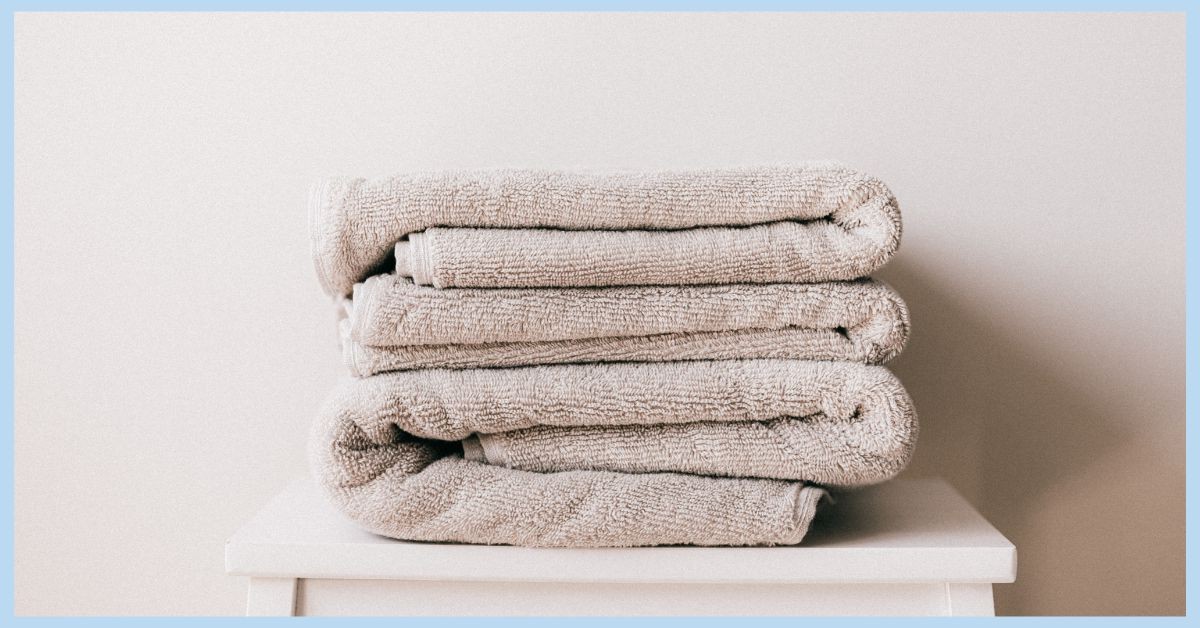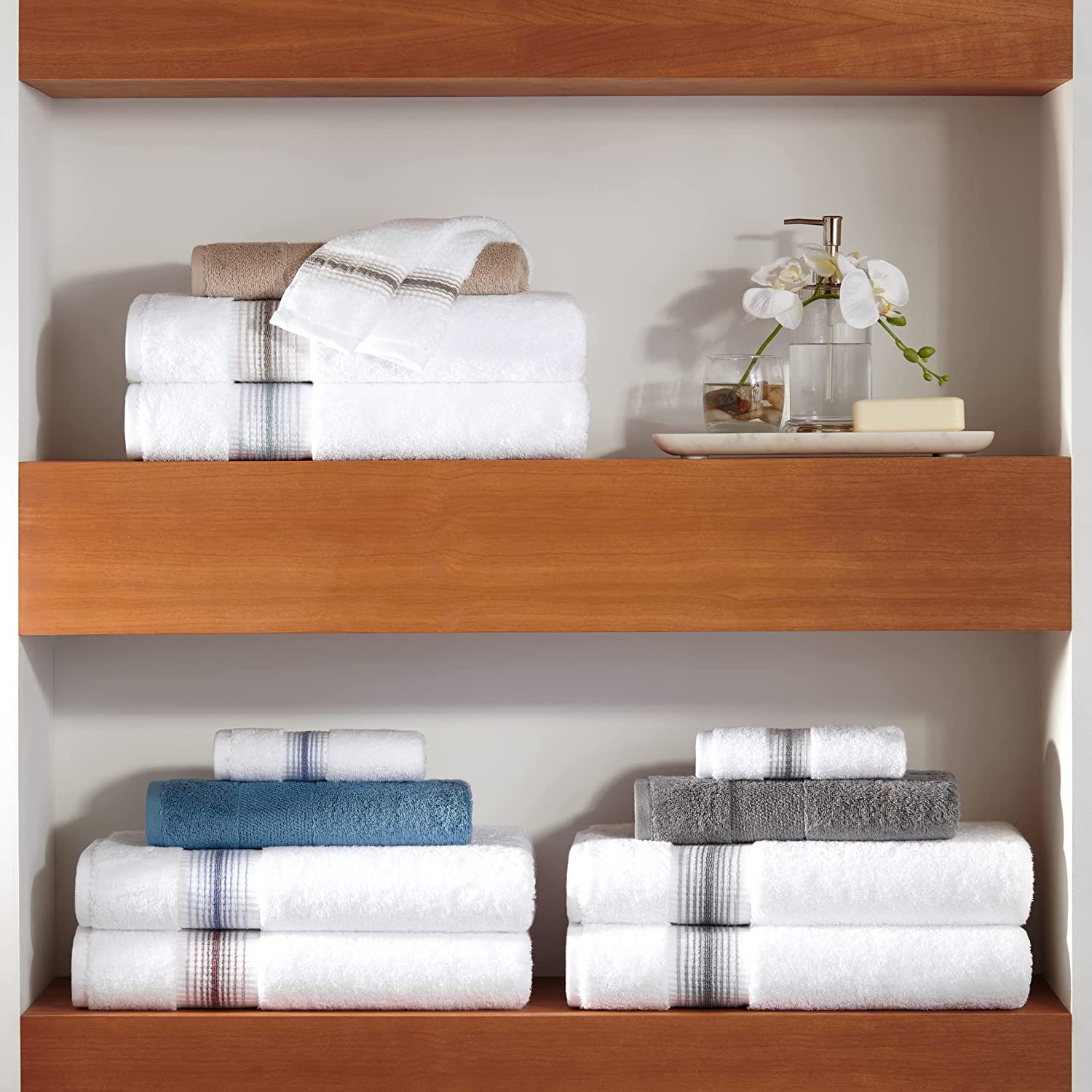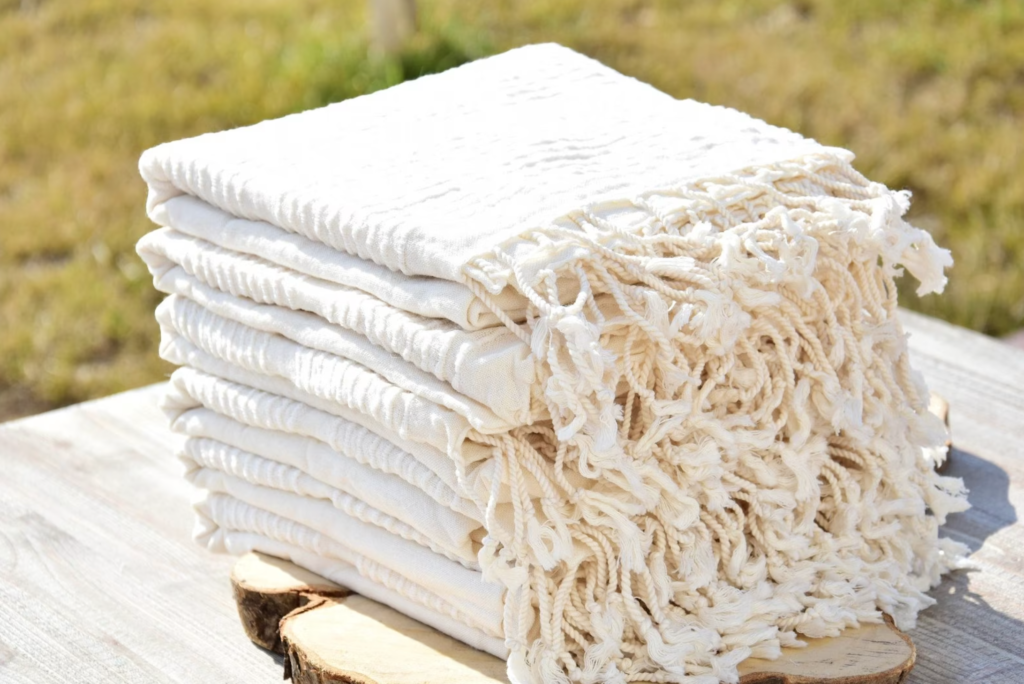Welcome to a guide all about Turkish towels! Turkish beach towels are known as much more than just a regular beach accessory and Turkish bath towels are cozy and functional to use at home. Both have their own distinct history, characteristics, and benefits that make them stand out from other types of towels.
What is a Turkish beach towel and how is it different from a Turkish bath towel?
A Turkish beach towel, also known as a peshtemal (peştemal in Turkish), is a lightweight, patterned towel dating back hundreds of years. It was initially made popular by Persian and Ottoman hammam cultures. The towel is made of 100% cotton and woven in such a way that’s fast-drying, highly absorbent, and thinner than your average beach towel. Peshtemals often feature bold colors and patterns with small tassels at each end.
From many years of experience using peshtemals after a swim, I’d recommend taking two with you to the beach or pool. One peshtemal you can use to lie down on and one you can use to dry off after swimming. It’s not super nice to try to dry your face or hands with a sandy or dirty towel. They’re so thin I can always fit two pretty easily in my beach bag – which is not the case with regular beach towels (those can never fit well).
In contrast, a Turkish bath towel usually features just one color and a simple design. Its texture is typically terrycloth or fluffy loops; they also tend to be larger in size than standard bath towels. Unlike peshtemals, I’d recommend having just one Turkish body towel per person. Because they’re so fluffy and absorbent, just one can definitely dry you head to toe.
Important Note: You can use a peshtemal at home, too! They can totally fit it in with any style bathroom. Check out this one here on Etsy!
Origins of the Turkish Towel
Tracing its roots to Persia and the Ottoman Empire, the Turkish towel has since become an iconic symbol of Turkey’s culture and history.
Today, peshtemals are known for their softness, absorbency, and lightweight design. They’re often woven with natural dyes like indigo or madder root to create beautiful patterns that make them stand out from regular towels. This makes them perfect for beach trips or the pool as they dry quickly without leaving any annoying residue behind on your skin.
What really sets peshtemals apart is their durability; these textiles are designed to last through years of washing and use without fading or fraying at the edges. Plus, they come in a variety of sizes so you can find one that fits your needs perfectly – whether you’re looking for something large enough to wrap around yourself after a shower or small enough to take on vacation with you.
When it comes to care instructions, they don’t need that much compared to other fabrics like terry cloth or velour. To keep yours looking its best, simply wash in cold water with gentle detergent and then hang dry – no machine drying necessary.
Are Turkish towels eco-friendly?
Turkish towels (both bath and beach towels) are getting more and more popular for their superior absorbency and softness. But is it eco-friendly to produce them?
According to WWF, it takes more than 20,000 liters (5,283 gallons) of water to produce just one kilogram (2.2 pounds) of cotton, which roughly equals one t-shirt and a pair of jeans (about a regular bath towel, you could say). Cotton-based towels, in general, aren’t very eco-friendly.
In terms of the towel industry, the true answer hinges on the towel’s production techniques and the kind of cotton used.
When compared to non-cotton based towels, both Turkish towels tend to require a lot more water and energy in their production process. For example, traditional terrycloth towels are made from shorter fibers that can be spun quickly with less water. The long fibers on Turkish towels take more cotton, and therefore more water, than shorter fibers.
Some manufacturers use chemical dyes or bleach when making Turkish towels which adds additional environmental costs. The use of chemicals in the production of Turkish towels should be taken into account when looking at their ecological friendliness, as bad disposal may lead to negative effects.
The kind of cotton used is also an essential factor. Turkish towels sometimes use Egyptian cotton which creates longer fibers and denser threads. But then it takes these towels longer to dry and requires more water to produce. Turkish cotton, on the other hand, has fewer joints, meaning less flyaway strands or piling in strands.
If you’re looking for an eco-friendly Turkish peshtemal, check out this one by Serena & Lily.
How are Turkish towels different from regular towels?
Once you’ve tried a Turkish towel, you can’t go back! That’s how different it is from regular towels. They’re memorably distinct from other kinds of towels.
Material:
Turkish towels are made from high-quality cotton, usually sourced from Turkey or Egypt. The fibers used in these towels are more durable than those found in regular towels, so they will last longer and won’t pill or fade over time. This makes them perfect for regular use after the shower or washing hands, and for long staycation trips where you need something that can stand up to the wear and tear of travel.
Design:
Turkish towels vary a lot in design! You can see towels all the way from colorful intricate patterns woven into the fabric to simple plain white towels without anything on them. Because there are so many options, you can find any matching design to fit the design in your mind. Especially if you visit Turkey in-person, I’d recommend stopping by the Grand Bazaar and buying two peshtemals and an authentic Turkish cotton-based Turkish towel set to take home (or even gift someone).
Weight & Size:
Another key difference between Turkish and regular towels is their weight and size – most Turkish models weigh less than standard bath towels while also being larger due to their thinner material construction (which helps reduce bulk). This makes them ideal for packing into suitcases or backpacks since they take up less space but still provide plenty of coverage when needed after showering or swimming at the beach/poolside.
Thanks to its lightweight construction and tightly-woven cotton fibers, genuine Turkish towels typically have superior absorbency – so you can dry off in a jiffy. This means that, with a Turkish towel, you won’t have to waste precious holiday time waiting outside of showers or bathrooms to get completely dried off before getting dressed again.
How to decide if Turkish towels are right for you
If you’re looking for a towel to take on trips or need a new set for your bathroom, Turkish towels could be exactly what you’re looking for. If you’re looking for something lightweight, fluffy, absorbent, and soft, then Turkish towels may be perfect for you. If you need something with greater absorbency and heft, then Egyptian cotton could be the right choice.
Turkish towels are generally made from either 100% cotton fibers; however, some brands offer special blends which can add extra softness or durability. Blended materials, although typically pricier than pure cotton towels, can have the advantage of improved absorbency and extended life.
Size matters too. Most people prefer smaller sizes when buying Turkish towels because they take up less space when folded away – great if storage space is at a premium in your home. However, larger sizes can also work well depending on how much coverage and absorbance you need.
Aesthetics play an important role – after all, no one wants their bathroom and kitchen accessories to clash with each other. Thankfully, most brands offer plenty of colors and designs so finding one that suits your style shouldn’t be difficult at all. Look out for any details like tassels or fringes – these can add texture and aesthetic.
Finally, quality should never be overlooked. This is especially true when it comes to choosing between different brands, as not all companies use high-grade materials nor do they employ skilled artisans. Before deciding on a product, check out customer reviews for an insight into the quality and satisfaction levels.
How can you tell if a Turkish towel company has high-quality or low-quality towels?
When it comes to buying Turkish towels, you want to make sure that you’re getting the best quality possible. Determining the quality of Turkish towels can be a challenge, yet there are certain elements to look for when making your selection.
Material:
The material used in a towel will have an effect on its quality. High-end Turkish towels are often crafted with 100% cotton, while cheaper versions may be composed of synthetic fabrics such as polyester and rayon. Natural fabrics, such as cotton, tend to be more absorbent and longer-lasting than synthetic materials like polyester or rayon. Additionally, look for organic cotton if environmental friendliness is important to you.
Weave:
The weave of a towel also affects its quality; higher thread counts can mean softer fabric with better absorbency and durability over time. A basic guideline is to steer clear of any towel that has less than a 300 GSM (grams per square meter = g/m2), as it won’t endure washing and will start to fray or become misshapen quickly.
Fringe:
Look for fringe that’s evenly cut and free from loose threads – this indicates higher craftsmanship standards in the manufacturing process and ensures your towel will stay looking great for longer periods of time without needing repairs or replacement sooner than expected.
Dyeing Process:
If the colors on your Turkish towel fade quickly after washing then it likely means they weren’t dyed properly during production – high-quality dyes should retain their vibrancy even after multiple washes. Low-grade dyes might also bleed onto other items when washed together so always check labels carefully.
Size & Weight:
Size matters when it comes to choosing a good quality Turkish towel – heavier weight fabrics tend to hold up better over time while lighter weights may fray easily or become misshapen with repeated use and laundering cycles. Also pay attention to size – larger towels will provide more coverage while smaller ones might not meet all your needs (or those of your guests).
Finally, take some time to feel each type of fabric available at the store before making your purchase decision. Higher grade materials should feel smooth against skin without any roughness due to poor weaving techniques or inferior fibers being used during production processes such as dyeing and bleaching.
When looking for a Turkish towel company, it is important to research the quality of their products. With proper preparation and care, high-quality towels can last many years and provide luxurious comfort. Next, we will discuss how you should prepare these Turkish towels for first-time use in order to get the most out of them.
How should you prepare Turkish towels for first-time use?
Before you use a Turkish towel for the first time, it’s important to prepare it properly.
First, wash your new Turkish towels in cold water with a mild detergent. This helps remove any excess dyes or chemicals used during the manufacturing process. If possible, avoid using fabric softeners as these can cause buildup on the fibers of your towels and reduce their absorbance over time.
Next, tumble dry on low heat or hang them outside (if it’s warm outside) to save energy, keep colors vibrant, and prevent fabrics from shrinking too much. Avoid using high heat settings when drying as this can damage delicate fabrics like those found in Turkish towels.
Fold your Turkish towels into thirds lengthwise, taking care to avoid wrinkles. If the towel has fringed edges, tie up any loose threads before storing it away in order to prevent further unraveling – this is especially important if you plan on washing them frequently since washers and dryers can loosen threads faster than regular wear-and-tear.
By taking proper care of your Turkish towels right off the bat, and then continuing with regular maintenance afterwards, you can enjoy their luxurious feel and superior absorbency for many years to come.
Can Turkish towels go in the washer and dryer?
Yep, Turkish towels can typically go in both the washer and dryer. I recommend checking the towel’s little brand label for fabric care instructions. Don’t know what those symbols mean? Here’s a laundry symbols cheatsheet.
To maintain the quality of Turkish towels, it’s generally important to use cold water and a mild detergent specifically designed for delicate fabrics. Don’t use bleach or fabric softener on your Turkish towel; these will damage the fibers of the fabric and make them less absorbent over time. Be sure to wash your towels separately from other items such as jeans or t-shirts (this could cause pilling of the fabric).
If pilling has already happened, I’d recommend this handheld pilling cleaner (on Amazon).
After washing, you should hang your Turkish towel up to air dry rather than putting it directly into a hot dryer. This will help preserve its color and texture for longer periods of time. If you do put it in a dryer, however, set it on low heat.
How can you make a Turkish towel softer and more absorbent?
The best way to make a Turkish towel softer and more absorbent is to wash it on delicate with good quality natural softener and cold water. First, it’s important to understand that Turkish towels are generally made from 100% cotton which is highly absorbent, but not necessarily soft.
Put the towel in a wash cycle with high-quality fabric softener right after you buy it and also after every 3rd or 4th use (the recommended frequency to wash towels). This will get rid of unwanted chemicals left on the towel from its production and will make its fibers much softer against your skin.
If you don’t have access to a washer or dryer, you can still hand-wash your towels using gentle detergent or nontoxic soap and hang them up either outside or inside to dry.
How can you fix pulled threads or unraveled fringe on a towel?
Unraveled fringe or pulled threads can be a problem with towels. For starters, if the fringe is just starting to come undone at the end of your towel, you may be able to simply cut off the loose ends and try to re-sew them back on. This’ll require some basic sewing skills but shouldn’t take too long. If this doesn’t work for you, there are other options available like this fabric glue (on Amazon).
If the thread has already been pulled out from your Turkish towel, then it can be more difficult to repair but not impossible! You could try tying two pieces of thread together in a knot near where the pull occurred and then sew it into place using small stitches around the area so that it holds securely. If all else fails, then buying another piece of matching fabric and cutting out patches from it before attaching them with either glue or stitches is also an option worth considering.
What is the difference between Turkish, Egyptian, and Pima cotton?
Turkish, Egyptian, and Pima cotton are 3 of the most popular types of cotton used to make towels. Though originating from different places, these three types of cotton can all make great towels!
All 3 cottons are known for their softness and luxurious feel on the skin. Turkish cotton, produced in Turkey, is famed for its lengthy fibers that are absorbent but lightweight. Egyptian cotton comes from Egypt and has an even longer fiber length than Turkish cotton making it even softer to touch. Pima cotton is known as an “extra-long staple cotton” and is grown mostly in the U.S., Peru, and Australia. Both Turkish and Egyptian cotton are more absorbent compared to Pima cotton.
Price is always a consideration, but there are expensive, high-end Turkish, Egyptian, and Pima cotton towels all around the world, so one type isn’t necessarily better value than another. It’s definitely more nuanced than that.
FAQs
What are Turkish towels used for?
Turkish towels are primarily used for drying one’s body off after a shower, hand wash, or swimming. Both bath and beach Turkish towels are absorbent and dry relatively faster than regular towels, so you don’t have to worry about drying off. And peshtemals can be used 30+ different ways! Also, instead of eventually throwing them away, you can use your old and super worn Turkish towels as cleaning rags to lengthen their lives.
Why are Turkish towels better?
Turkish towels have been gaining popularity over the last 10 years (in my educated opinion) because good ones are really fluffy, highly absorbent, and long-lasting. I’ve used Turkish towels for pretty much my entire life and they’ve always been nicer than the towels from the local store.



